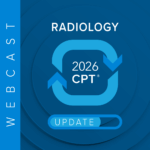Upper extremity coding for computed tomography carries serval distinct codes worth noting. Coding for this scenario requires some basic understanding of the nuances and rationale behind these codes. In particular, Code 73206 holds some distinct differences as opposed to its counterparts 73200–73202. Let’s review this area of coding for success throughout 2023 and beyond.
Solidifying Service Knowledge
First, it is necessary to understand the service itself for fundamental knowledge. The mission of extremity CT is to analyze soft tissue and/or bone neoplasms. In most cases, studies tend to be done with contrast material, focusing primarily on the extremity in question. However, serval codes are still reportable for “without contrast material.” Even more, abscess evaluation is an additional use for this study. Coders and compliance professionals should be aware that CPT® also provides a separate charging option for performing CTA as well as conventional CT imaging.
Coding for 73200–73202
Generally speaking, both sides of the extremity are included in the scanning area (field of view), the affected side and the opposite side for comparison. What should be done if only one side was specifically ordered? In this case, only one charge can be submitted. In the case that a bilateral study was requested and performed, you may charge for both sides.
| 73200 | CT, upper extremity; without contrast material |
| 73201 | CT, upper extremity; with contrast material(s) |
| 73202 | CT, upper extremity; without contrast material, followed by contrast material(s) and further sections |
Payment Policies for 73200–73202
One area of clarification that is important to specify is where these codes fall under in terms of Medicare payment. Medicare payment rules show codes 73200–73202 classified as “Bilateral Surgery—200%.” Medicare gives the following explanation of this payment policy:
“The usual payment adjustment for bilateral procedures does not apply. If the procedure is reported with modifier 50 or is reported for both sides on the same day, by any other means (e.g., with RT and LT modifiers or with a 2 in the units field), base the payment for each side or organ or site of paired organ on the lower of (a) the actual charge for each side or (b) 100% of the fee schedule amount for each side. If the procedure is reported as a bilateral procedure and with other procedure codes on the same day, determine the fee schedule amount for a bilateral procedure before applying any multiple procedure rules. Services in this category are generally radiology procedures or other diagnostic tests which are not subject to the special payment rules for other bilateral surgeries.”
Code 73206 Payment Policies
Code 73206 contains some key differences from its family codes.
| 73206 | Computed tomographic angiography, upper extremity, with contrast material(s), including noncontrast images, if performed, and image postprocessing |
Medicare rules differ with the indicator used in surgery. The Medicare payment rules for code 73206 show the bilateral surgery indicator as “0.” This means:
“150% payment adjustment for bilateral procedures does not apply. If procedure is reported with modifier 50 or with modifiers RT and LT, base the payment for the two sides on the lower of: (a) the total actual charge for both sides or (b) 100% of the fee schedule amount for a single code.”
Understand that CTA is a method of imaging vascular anatomy in a minimally invasive way. In most instances, a CT imaging sequence without contrast is performed for localization of the site to be studied during the enhanced scan (with contrast). To demonstrate that not all CTA studies include these non-contrast images, each CTA code descriptor states “with contrast material(s), including noncontrast images, if performed.”
Note that although separate reimbursement may be allowed when contrast material is administered via an intravenous (IV) method for this study (verify local payer requirements and rules), do not charge separately for the surgical code for the venous injection of this material. At the time of publication, the most current CCI narrative instructions state the following (Chapter 9, subsection D, #1):
“If a radiologic procedure requires that contrast be administered orally (e.g., upper GI series) or rectally (e.g., barium enema), the administration is integral to the radiologic procedure, and the administration service is not separately reportable. If a radiologic procedure requires that contrast material be administered parenterally (e.g., IVP, CT, MRI), the vascular access (e.g., CPT® codes 36000, 36406, 36410) and contrast administration (e.g., CPT codes 96360–96376) are integral to the procedure and are not separately reportable.
While other methods may be used to study arteries and veins (contrast arteriograms and/or venograms), CTA studies are performed by rapid injections of contrast material to allow computer processing of the acquired data into three-dimensional images. The resultant images can then be further manipulated and/or adjusted for precise analysis and viewing of any atypical venous or arterial anatomy. 3-D post-processing must be performed to assign a CTA code. It is inappropriate to also use codes 76376 or 76377 for that portion of study, as the definition of all CTA codes explicitly includes ‘image post processing.’”
This is not all the knowledge necessary for correct and compliant CT, CTA, and MRI coding. As service volumes rebound, now more than ever, it is imperative to make sure your CPT® coding is correct and compliant. Explore our CT/MR Coder for more success today and throughout 2023.













